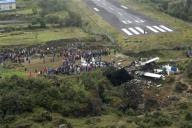
Things are in tumult at Minnesota-based Sun Country Airlines. Like so many other carriers, Sun Country has been struggling financially for months in the face of huge increases in fuel prices, coupled with a general economic downturn. More recently, another significant problem arose when the CEO of the airline's parent, Petters Group Worldwide, was
arrested on federal charges of mail and wire fraud, money laundering and obstruction of justice. While the federal investigation that led to the arrest apparently pertained to a unit of the Petters Group separate from the airline, continued financing for the aviation unit has been jeopardized as a result.
Late last week, Sun Country CEO Stan Gadek met with the airline's pilot and flight attendant unions to explain that a planned-for loan from the parent company to cover expenses during the current quarter would not be possible, now that the airline needed to separate itself financially from the Petters Group. With such financing suddenly unavailable,
Gadek told employees that in addition to rescheduling payments to vendors and generating other sources of cash, the airline would have to further reduce wages in order to stay in business. To that end, Gadek announced that all employees would have to take a 50% "pay deferral," beginning with their October 7, 2008 paychecks.
Under terms of the "pay deferral," communicated to employees in a letter from the Sun Country CEO, the "reduction in payroll will be recorded as back wages owing to employees and accruing interest at a nominal rate." In other words, the intention is to pay back the "deferred" wages to employees, with interest, when -- and if -- the company gets back on solid ground financially. The letter to employees also stated that Gadek himself will "work without pay until this crisis is resolved."
Everyone wants to believe that Sun Country will be able to make it through the cash crunch intact, but things are shaky enough that the airline
issued a WARN letter to employees on October 1, notifying them of the possibility that they might be jobless by December 1, 2008. [Under the provisions of the federal Worker's Adjustment and Retraining Act (WARN Act), employers are required to provide notice 60 days in advance of a shutdown or mass layoff.] The letter said, in part:
...[T]his is to notify you that should Sun Country not be able to obtain additional financing or obtain relief from our major creditors in the near future there is a distinct possibility that the airline will be shut down and/or you will be furloughed. While the timing of this action is not predictable at this time, you should prepare yourself for the possibility that such a shut down or furlough could impact your employment as early as December 1, 2008. Depending on what happens, such an employment loss could be temporary or permanent and could affect all Sun Country employees or a subset of employees that includes you.
Sun Country's pilots, represented by the Air Line Pilots Association (ALPA), released a
statement in response to the WARN letter, saying that they had made no commitments to management and no negotiations are scheduled at this time. The pilots' union states that they are leaving all options open "during this period of evolving circumstances."
Last spring,
45 Sun Country pilots were furloughed involuntarily in conjunction with a capacity reduction. At the time they were announced, those furloughs were expected to run from May 1, 2008, through October 31, 2008.
UPDATE Oct. 6, 2008: Local media in Minnesota are reporting this morning that Sun Country Airlines has filed for Chapter 11 bankruptcy protection. Airline officials announced that Sun Country intends to continue to fly its regular schedule.
[Photo Source]
 A Boeing 737-800 aircraft operated by Spanish airline Air Europa overran a runway at Lanzarote Airport (Arrecife) in the Canary Islands. The incident occurred early this morning, October 31, 2008. No one was injured, and there were no immediate reports of significant damage to the aircraft.
A Boeing 737-800 aircraft operated by Spanish airline Air Europa overran a runway at Lanzarote Airport (Arrecife) in the Canary Islands. The incident occurred early this morning, October 31, 2008. No one was injured, and there were no immediate reports of significant damage to the aircraft.






















